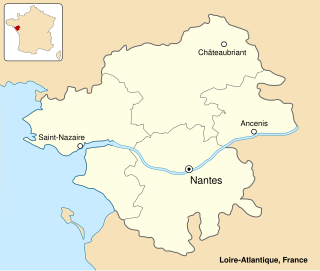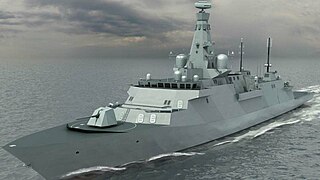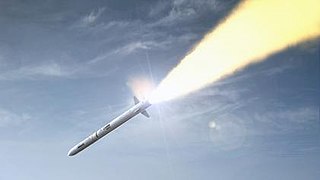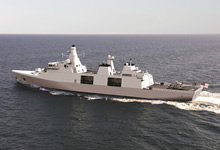
The Type 23 frigate or Duke class is a class of frigates built for the United Kingdom's Royal Navy. The ships are named after British Dukes, thus leading to the class being commonly known as the Duke class. The first Type 23, HMS Norfolk, was commissioned in 1989, and the sixteenth, HMS St Albans was commissioned in June 2002. They form the core of the Royal Navy's destroyer and frigate fleet and serve alongside the Type 45 destroyers. They were designed for anti-submarine warfare, but have been used for a range of uses. Eleven Type 23 frigates remain in service with the Royal Navy, with three vessels having been sold to the Chilean Navy, and one being retired in 2021, and a second one being retired in 2023.

The St Nazaire Raid or Operation Chariot was a British amphibious attack on the heavily defended Normandie dry dock at St Nazaire in German-occupied France during the Second World War. The operation was undertaken by the Royal Navy (RN) and British Commandos under the auspices of Combined Operations Headquarters on 28 March 1942. St Nazaire was targeted because the loss of its dry dock would force any large German warship in need of repairs, such as Tirpitz, sister ship of Bismarck, to return to home waters by running the gauntlet of the Home Fleet of the Royal Navy and other British forces, via the English Channel or the North Sea.

The Type 22 frigate also known as the Broadsword class was a class of frigates built for the British Royal Navy. Fourteen were built in total, with production divided into three batches.

The Type 45 destroyer, also known as the D or Daring class, is a class of six guided-missile destroyers built for the United Kingdom's Royal Navy in the early 21st century. The class is primarily designed for anti-aircraft and anti-missile warfare and is built around the PAAMS air-defence system using the SAMPSON Active electronically scanned array (AESA) and the S1850M long-range radars. The first three destroyers were assembled by BAE Systems Surface Fleet Solutions from partially prefabricated "blocks" built at different shipyards; the remaining three were built by BAE Systems Maritime – Naval Ships. The first ship in the Daring class, HMS Daring, was launched on 1 February 2006 and commissioned on 23 July 2009.

HMS Campbeltown was a Batch 3 Type 22 frigate of the British Royal Navy. Built by Cammell Laird Shipbuilders Ltd. in Birkenhead. She was part of the third batch of Type 22s, which were larger than their predecessors and incorporated advanced close-in weapons after lessons learnt from the 1982 Falklands War. She was decommissioned on 7 April 2011.

Future planning of the Royal Navy's capabilities is set through periodic Defence Reviews carried out by the British Government. The Royal Navy's role in the 2020s, and beyond, is outlined in the 2021 defence white paper, which was published on 22 March 2021. The white paper is one component of the Integrated Review of Security, Defence, Development and Foreign Policy, titled as Global Britain in a Competitive Age which was published on 16 March 2021.

The Type 26 frigate or City-class frigate is a class of frigate being built for the United Kingdom's Royal Navy, with variants also being built for the Australian and Canadian navies. The programme, known as the Global Combat Ship, was launched by the UK Ministry of Defence to partially replace the navy's thirteen Type 23 frigates, and for export. Its primary role is to conduct advanced anti-submarine warfare missions while supporting air defence and general purpose operations. The type is the first naval platform shared between Australia, Canada and the United Kingdom since the Tribal-class destroyer.
Two ships of the Royal Navy have borne the name HMS Campbeltown, after Campbeltown in Scotland, with a third announced:

HMS Campbeltown was a Town-class destroyer of the Royal Navy during the Second World War. She was originally US destroyer USS Buchanan, and was one of 50 obsolescent U.S. Navy destroyers transferred to the Royal Navy in 1940 as part of the Destroyers for Bases Agreement. Campbeltown became one of the most famous of these ships when she was used in the St Nazaire Raid in 1942.
The Royal Australian Navy, although a significant force in the Asia-Pacific region, is nonetheless classed as a medium-sized navy. Its fleet is based around two main types of surface combatant, with limited global deployment and air power capability. However, in 2009, a white paper, Defending Australia in the Asia Pacific Century: Force 2030, was produced by the Australian government which set out a programme of defence spending that will see significant improvements to the RAN's fleet and capabilities.

The CAMM is a family of surface-to-air missiles developed by MBDA UK for the United Kingdom. CAMM shares some common features and components with the ASRAAM air-to-air missile, but with updated electronics and an active radar homing seeker.

The Iver Huitfeldt class is a three-ship class of air defence frigates that entered service with the Royal Danish Navy in 2012 and 2013.

The FC/ASW, FMAN/FMC or SPEAR 5 is a programme launched by France and the United Kingdom to develop a missile system to replace their jointly-developed Storm Shadow/SCALP as well as their respective Exocet and Harpoon anti-ship missiles. Equally funded by both countries, the project is led by European missile manufacturer MBDA and is a product of the close defence relationship set out between both nations by the Lancaster House treaties.
The National Security Strategy and Strategic Defence and Security Review 2015 was published by the British government during the second Cameron ministry on 23 November 2015 to outline the United Kingdom's defence strategy up to 2025. It identified key threats to the UK and the capabilities it required to address them.

The Type 31 frigate or Inspiration class, and formerly known as the Type 31e frigate or General Purpose Frigate (GPF), is a planned class of frigate intended to enter service with the United Kingdom's Royal Navy in the 2020s alongside the submarine-hunting Type 26 frigate. Designed by Babcock International, it is also marketed under the name Arrowhead 140 and is based on Odense Maritime Technology’s (OMT) Iver Huitfeldt-class frigate hull.

The Constellation class is a class of multi-mission guided-missile frigates under development for the United States Navy as a follow-on to the modular but problematic littoral combat ship. The U.S. Navy announced the FFG(X) frigate project in the United States Department of Defense Request For Information (RFI) on 10 July 2017.
HMS Active is a planned Type 31 frigate and the thirteenth vessel of the Royal Navy to carry the name. In May 2021, the names of the five planned Type 31 ships were announced by the First Sea Lord. The names were selected to represent key themes that represent the future plans of the Royal Navy and Royal Marines - forward deployment of ships overseas; operating in the North Atlantic; carrier operations; technology and innovation; and the Future Commando Force.
HMS Bulldog is a Type 31 frigate of the Royal Navy and the eighth vessel named Bulldog. The name was selected to represent key themes that represent the future plans of the Royal Navy and Royal Marines.
HMS Formidable is a Type 31 frigate of the Royal Navy and the sixth vessel named after the word formidable. In May 2021, the names of the five planned Type 31 ships were announced by the First Sea Lord. The names were selected to represent key themes that represent the future plans of the Royal Navy and Royal Marines - forward deployment of ships overseas; operating in the North Atlantic; carrier operations; technology and innovation; and the Future Commando Force.
HMS Venturer is the lead ship of the Type 31 frigate-class currently under construction for the Royal Navy and the seventh vessel named HMS Venturer.












